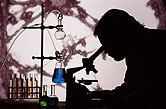New Genetic Clues to Severe Childhood Epilepsy
Exome sequencing technique may lead to discoveries about many diseases, researchers say.
A new technique used to identify genes associated with severe forms of childhood epilepsy could be used to find and confirm other gene mutations that cause neurological disorders, researchers report.

The scientists performed a technique called exome sequencing to search for non-inherited gene mutations associated with epilepsy in 264 children whose parents do not have epilepsy. They identified 25 such mutations in six genes: two new genes and four that had been previously linked with epilepsy.
The two forms of epilepsy associated with these gene mutations are called infantile spasms and Lennox-Gastaut syndrome, according to the study.
Exomes represent all of a person's genes. Their DNA sequences provide the instructions for building all the proteins made by the body. The findings suggest that exome sequencing may be a highly effective way to find and confirm many disease-causing gene mutations.
"This moderately sized study identified an unusually large number of disease-causing mutations and provides a wealth of new information for the epilepsy research community to explore," expert said.
More than 2 million people in the United States have epilepsy, and infants and children are more likely to have epilepsy than adults. Some studies have identified genes associated with rare inherited forms of epilepsy, but finding genes associated with the majority of epilepsies has been difficult.
"Unlike some diseases, many of the genetic mutations associated with severe childhood epilepsies appear to be new mutations that are not inherited," expert said.
The researchers estimated that up to 90 genes could have epilepsy-causing mutations and that many of the mutations associated with epilepsy risk have previously been linked to other neurodevelopmental diseases, including autism.
It appears that a few pathways may be responsible for many severe pediatric epilepsies. If true, then understanding epilepsies will be more manageable and we can find common pathways to target with drugs and other therapies.
Source: U.S. Dept. of Health & Human Services
- 383 reads
Human Rights
Fostering a More Humane World: The 28th Eurasian Economic Summi

Conscience, Hope, and Action: Keys to Global Peace and Sustainability

Ringing FOWPAL’s Peace Bell for the World:Nobel Peace Prize Laureates’ Visions and Actions

Protecting the World’s Cultural Diversity for a Sustainable Future

Puppet Show I International Friendship Day 2020

